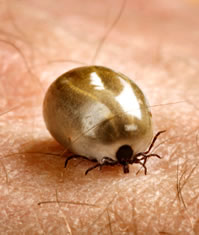Lyme Disease <<< Click here to go back
 BACKGROUND:
BACKGROUND:
Lyme disease is the most vector-born infection in the U.S. And is the
fastest-growing epidemic in the world. According to the CDC (Center
of Disease Control) confirms that" there is a considerable under-reporting"
of Lyme disease, maintaining that the actual infection rate may be 1.8
million, ten times higher than the 180,000 cases currently reported.
Nick Harris, Ph. D, Director of the International Lyme and Associated
Disease Society (ILADS), states" Lyme is grossly under-reported. In
the U.S. We probably have about 200,000 cases per year." Dan Kinderleher,
M.D. An expert on Lyme disease, stated on the Today Show on June 10,
2002 that the number of cases may be 100 times higher (18 million in
the U.S. alone) than reported by the CDC. Conventional belief attributes
Lyme disease through tick bites, classical Lyme is caused by a bacterial
spirochete, called Borrelia Burgdorferi. More recent literature has
shown it to be contracted also by:
- Mosquitoes
- Spiders
- Stinging Flies
- Mites and fleas
Some people may have contracted the disease through body fluids or from the placenta of their mother's womb or breast milk, rather than a tick bite. This means that the disease may be much more widespread than anticipated.
CHARACTERISTICS:
Borrelia Burgdorferi moves through the blood and tissue by means of an internal arrangement of flagellae that propel it in a corkscrew fashion. It can invade the various body systems and remain dormant for long periods of time only to cause illness months or years later when the immune system becomes compromised. Lyme spirochetes are masters of collagen tissue and they can travel through them easier than through blood. Zambrano, m. et aL. "Borrelia Burgdorferi binds to, invades, and colonizes native Type 1
collagen" Lattices, Infect Immune 2004; 72 (6):3138-46. Spirochetes are regularly found in people who have been on antibiotic therapy for years. Research suggest these atypical forms may allow Borrelia to survive antibiotic treatment infection, 1996 Vol.24 (3):218
The Lyme organism is highly adaptable and can change from the spirochetal form into encysted form from which they can emerge from the red blood cell when conditions improve. This phenomenon is what makes Lyme disease so difficult to diagnose and treat.
For more information on Lyme Disease click the pdf's below:
 There Is Hope for Chronic Lyme Disease
There Is Hope for Chronic Lyme Disease